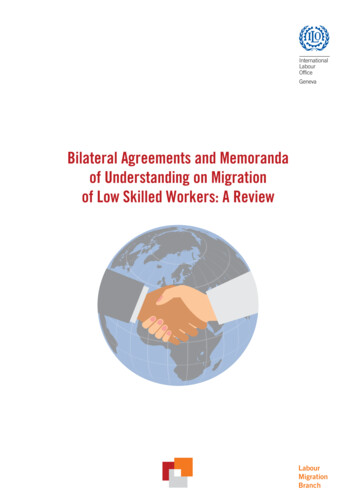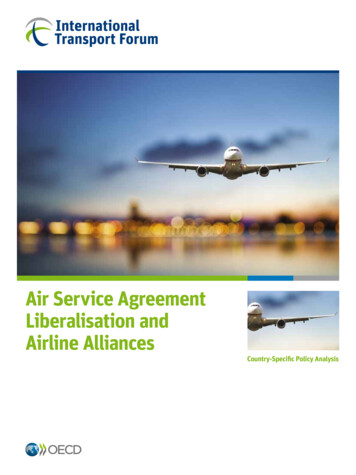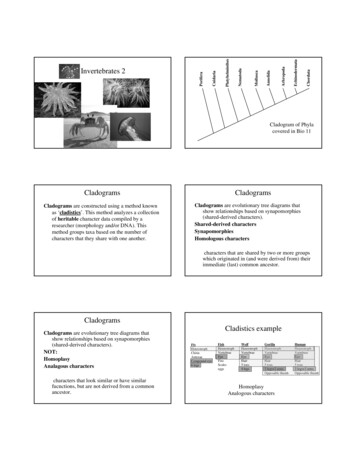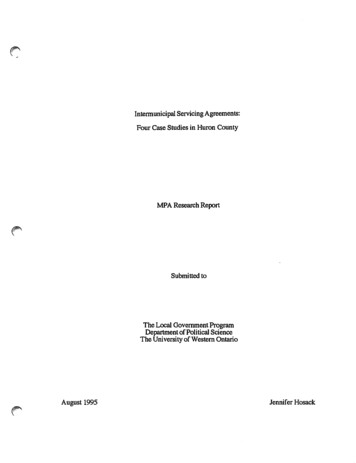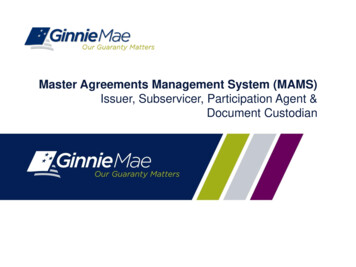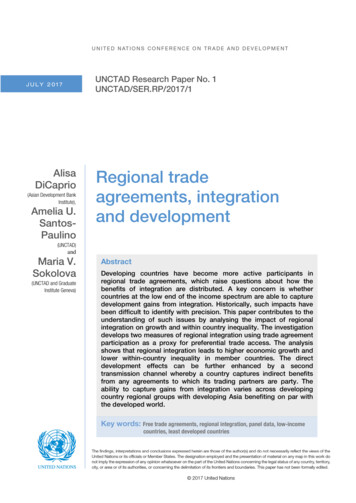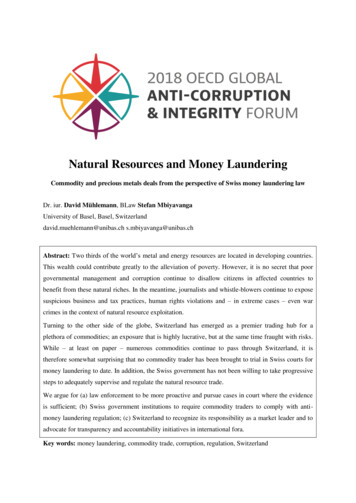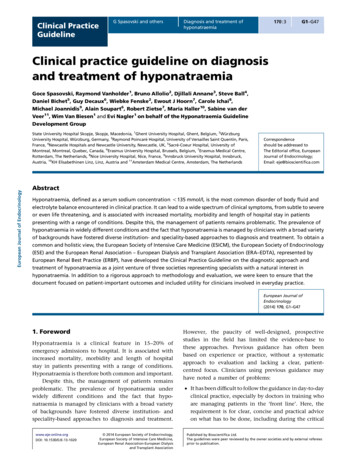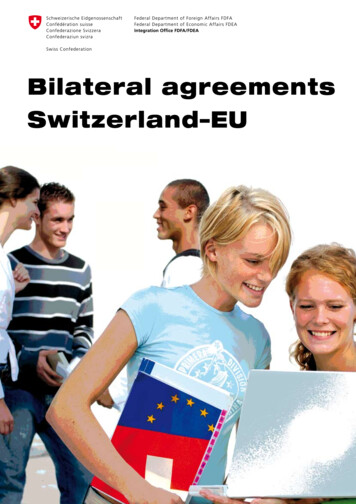
Transcription
Bilateral agreementsSwitzerland–EU1
BILATERALContentsForewordSwiss European policy the bilateral pathFree TradeInsuranceFree movement of persons: Swiss citizens in the EUFree movement of persons: EU citizens in SwitzerlandTechnical barriers to tradePublic procurementResearchAgricultureOverland transportCivil aviationSchengenDublinTaxation of savingsFight against fraudEnvironmentProcessed agricultural productsMEDIAPensionsStatisticsEducation, vocational training and youthQuestions and 4042
AGREEMENTSEuropean policy is a high priority of Swiss foreign policy. This is not surprising given Switzerland’s geopolitical position in the middle of Europe. Our EUneighbours are our most important partners – and not only from a politicalpoint of view. They are also important for Switzerland from an economicperspective because we earn every third franc through our economic relations with the European Union. The legal basis of this close cooperation isformed by bilateral agreements.Switzerland pursues its interests with respect to the EU via the so-called“bilateral path”. The two partners negotiate contractual agreements in selected sectors of mutual interest. On the one hand, these improve reciprocal market access for companies or regulate related aspects of productsafety, employee protection and health. On the other hand, they enablecloser cooperation in areas such as research, security, asylum, the environment, education and culture. Switzerland also contributes towards theMicheline Calmy-ReyFederal Councillordevelopment of Europe through various commitments. Examples are theenlargement contributions to reducing social and economic disparities inEurope, Switzerland’s involvement in peace missions in south-east Europe,and its participation in the Council of Europe’s efforts to promote respectfor human rights.Relations between Switzerland and the EU have developed over decades.The bilateral agreements have been extended step by step. Importantstages of this European policy have been assessed and approved by thepeople in referendums. This pragmatic approach has made it possible tofind tailor-made solutions in a number of areas.This brochure gives an overview of the respective bilateral agreements. Wewish you enjoyable reading.Doris LeuthardFederal Councillor3
BILATERALSwiss European policy –the bilateral pathSwitzerland is situated in the middle of Europe. Apart from the Principality of Liechtenstein, the EU is Switzerland’s sole neighbour. It isalso the most important economic and political partner. These closeties require an active European policy. In this respect, Switzerlandrepresents its interests via the so-called bilateral path.Switzerland and the EU are more than just neighbours. In 2008, bilateraltrade passed the 1 billion franc mark – per day. Switzerland earns everythird franc through trade with the EU. Roughly 80% of exports are to the EU.Conversely, Switzerland is the third most important market for EU products.It ranks below the USA and Russia but ahead of China (2008).Politically, too, there are many mutual interests. Environmental matters,top-level research, refugee policy or the fight against organised crime areexamples of areas with an increasingly transnational character. Here, cooperation and transnational solutions are called for. This makes cooperationwith the EU very important.The mutual interests of Switzerland and the EU are regulated in clearlydefined areas by means of bilateral agreements. Following the 1972 FreeTrade Agreement and the subsequent Insurance Agreement (1989), thesystem of bilateral agreements has been continuously extended. Of importance are the 7 Bilateral Agreements I and the 9 Bilateral Agreements II.Since 2000, this “bilateral path” has been approved by the people of Switzerland in five referendums. Today, the contractual framework comprisesaround 20 main and 100 subsidiary agreements.interests, for example, those of the food industry, the financial centre andthe tourism sector. Above all, however, they extend the existing cooperationto political areas such as asylum, security and the environment.How will European policy develop in the future?Priority is given to looking after existing agreements. The implementationand further development of the individual agreements is an ambitious programme: They must be brought into force and extended to new EU states.Most agreements require updating in order to adapt to changing regulations. Other agreements are renewed at regular intervals.Wherever there are mutual interests, cooperation should be intensified,including in new areas. This is the case, for example with electricity. Theaim is a partial opening of the electricity markets while ensuring security ofsupply in the liberalised environment.A further new area of interest is the agricultural and food sector. The aimhere is to dismantle trade barriers such as customs duties or differingproduct regulations. Liberalised trade should apply to agricultural products(e.g. meat) as well as to the input factors of agricultural production (e.g.machines, fertilizers, etc.) and to processed food (e.g. chocolate).The third area is public health: illnesses do not stop at borders; dangeroussubstances or defective toys are sold all over Europe. For this reason, cooperation in the field of infectious diseases, food and product safety shouldbe intensified.Bilaterals I and IIThe Bilateral Agreements I were negotiated following the rejection of theEuropean Economic Area in a referendum. With the exception of the Research Agreement, these are classical market opening agreements whichtoday provide Switzerland with extensive access to the EU single marketwith 490 million potential consumers. This strengthens the competitivenessof Swiss companies against with their European competitors.How do the bilateral agreements work?The bilateral agreements are based on intergovernmental cooperation, i.e.no sovereignty rights are transferred to a higher instance (such as the EUinstitutions Commission, Council of the European Union, Parliament andCourt of Justice). Implementation of the agreements is the sole responsibility of the contract partners.Shortly after the successful conclusion of the Bilaterals I, there were already new areas of interest on the table. This led to further negotiationsand to the conclusion of the Bilaterals II which cover additional economicIn terms of content, the agreements are based on European law. Someregulate the recognition of the equal status of Swiss and European legislation (e.g. the reciprocal recognition of product regulations) or refer to the4
AGREEMENTSapplicable EU law. Others deal with cooperation between Switzerland andthe EU within the framework of EU agencies and programmes (e.g. in jointresearch).In order to preserve the advantages of these contractual rulings (e.g. unrestricted market access), it is sometimes necessary to adapt the agreementsto new legal developments. Problems can also arise in certain countries interms of application. The so-called mixed committees are responsible forquestions of this nature. These are bodies made up of representatives fromSwitzerland and the EU. Almost all important agreements are monitoredand administered by a mixed committee.Most of the agreements are contracts in their own right and can be terminated separately at any time. The Bilaterals I agreements are an exception.They were concluded as a package. Termination of one of them automatically results in all ceasing to apply.Solidarity with EuropeSwitzerland contributes to reducing social and economic inequalities in theEU in the form of the enlargement contribution for the new EU countries inEastern and Central Europe.This contribution is used to support specific projects chosen by Switzerland. This improves local living conditions, for example, in the fields of theenvironment, education and state institutions, and it creates increased security, stability and prosperity on the European continent.The Swiss electorate approved the statutory basis for this support in 2006.The projects will be implemented over the coming years.The Bilaterals IApproved by the electorate in 2000 (67%), effective since 2002 Free movement of persons: opening of the labour markets Technical barriers to trade: easier approval of products Public procurement: extended access to the Europeanprocurement market Agriculture: easier trade with specific products Overland transport: opening the markets for road and rail transport,securing the road-to-rail transfer policy Civil aviation: reciprocal access to the air transport market Research: Swiss participation in the EU research frameworkprogrammesThe Bilaterals IISchengen/Dublin approved by the electorate in 2005 (55%),implementation of the agreements in stages Schengen/Dublin: easier travel, improved cooperation insecurity matters, coordinated asylum policy Taxation of savings: cross-border taxation of savings income Fight against fraud: combating crimes such as smuggling Processed agricultural products: removal of customs dutiesand export subsidies for food industry products Environment: participation in the EU Environment Agency Statistics: harmonisation and exchange of statistical data MEDIA: access to EU subsidies for filmmakers Education: participation in EU education programmes Pensions: removal of double taxation5
BILATERALFree TradeThe EU is by far Switzerland’s most important tradingpartner. One of the mainstays of this economic successis the Free Trade Agreement which creates a free tradezone for industrial products that is customs and quotafree. It was signed in 1972 and is the basis of the closeeconomic relations between Switzerland and the EU.Two differing integration models formed in Europe in the late1950s: On the one hand the European Community (EC),which aimed to achieve very close economic and political tiesand, on the other hand, the European Free Trade Association (EFTA) of which Switzerland is still a member today. Thelatter was formed exclusively for the purpose of economiccooperation. In order to facilitate economic relations betweenthese groups of countries, the then EC and the individualEFTA states concluded free trade agreements. The Swisselectorate approved the corresponding 1972 Free TradeAgreement between Switzerland and the EC with a majorityof over 70%.GrowthTrading volumes have grown by around 6% a year over thepast ten years. In 2008, the Swiss industry exported goodsworth 132 billion francs to the EU. And Switzerland importedEU goods with a value of 154 billion francs. A large proportion of these movements of goods is covered by the FreeTrade Agreement.6The Free Trade Agreement liberalises trade in industrial products. It prohibits customs duties or quantity restrictions andother measures with the same effect. Examples of industrial products are watches or machines. Both are importantproduct groups for the Swiss export industry. These sectorsbenefit to a high degree. On the other hand, agricultural products are excluded from the agreement, although industriallyprocessed agricultural products enjoy special status and areregulated in a special protocol to the Agreement (see Agreement on processed agricultural products).Two thirds of Swiss exports are to the EU, four fifths of imports come from the EU. With its current 27 member states,the EU is by far Switzerland’s most important trading partner.Furthermore, Switzerland is the third-largest market for theEU (2008) and, together with the USA, China and Russia, isone of the four most important trading partners.In contrast to a customs union, the free trade partners determine their external custom tariffs and quotas for third statesindependently. It is for this reason that customs clearance stilltakes place at borders between the free trade partners. Thisis aimed at ensuring that imported goods only benefit fromthe preferential rules of the free trade agreement if they havetheir origin in the territory of the contract parties.
AGREEMENTSKey dataDate of signing: 22 July 1972Approval by the electorate and the cantons: 3 December 1972Date effective: 1 January 1973“The Swiss watch industry is very export orientedand is dependent on the different import regimes.The Free Trade Agreements fundamentally favourwatch sales by facilitating their export. Of particular importance are customs tariffs: Their abolitionwithin the framework of the Swiss EU Free TradeAgreement has made a major contribution towardsthe positive development of Swiss watch exportsto the EU. With a 32% share of the overall volume,the EU is the second most important market for theSwiss watch industry after Asia. France, Italy andGermany are particularly important markets. We arevery confident as regards the development of ourexports to the new EU member states. They alsobenefit from the Free Trade Agreement.Jean-Daniel Pasche, President of theAssociation of the Swiss Watch Industry”7
BILATERALInsuranceThe insurance industry is important for the Swiss econ-Swiss prosperity.must have personnel in the respective countries. The crossborder offering of insurance to Europe from Switzerland – forexample via the Internet – is not permitted. Life and pensionschemes are excluded from the Agreement.A Bilateral Insurance Agreement between Switzerland andthe EU has been in place since 1989. This enables Swissinsurers to open agencies and branches in the EU countries(freedom of establishment) via which they can offer casualtyinsurance. EU insurers have the same rights in Switzerland.Examples of casualty insurance are homeowners’, motorvehicle, transport, travel or liability insurance. The insurersSwiss insurers employ over 47,000 people in Switzerlandand 78,000 abroad (status 2007). Their annual revenue fromcasualty insurance is around 65 billion francs (2007) of whichapproximately two thirds are earned abroad. Numerous insurance companies have set up or acquired branches in theEU. This enables better international positioning by the companies concerned.omy. It employs over 125,000 people, more than halfabroad. Its added value makes a major contribution to8
AGREEMENTSKey dataDate of signing: 10 October 1989Date effective: 1 January 1993“The insurance industry welcomes the Bilateral Agreement in the field of casualtyinsurance. The European market is veryimportant for us and we are dependent onour ability to do business there as well.Even more welcome, however, would bethe possibility of offering insurance directlyfrom Switzerland – however, that is notpossible at present.Markus Hongler, Vice President of theSwiss Insurance Association”9
BILATERALFree movement of persons:Swiss citizens in the EUMany Swiss benefit from the freedom to look for employment in their preferred EU country. And companiesbenefit from the possibility of sending own personnelto the EU to carry out tasks on site.Today, over 400,000 Swiss live in the EU. There are manyreasons for this: some have found their dream job, othersaccompany their spouses abroad. Some go abroad to study,others spend their retirement near the sea. Thanks to the freemovement of persons, all Swiss are entitled to reside andwork in their preferred EU country.Swiss companies also make extensive use of the free movement of persons: First, because they can recruit needed specialists in the EU (see chapter “EU citizens in Switzerland”).Second, they now have the possibility of carrying out tasks inthe 27 EU states using their own personnel. They can sendemployees to EU states for up to 90 days a year, for example, to assemble or service machines, without the need for aresidence permit. Thanks to the recognition of professionalqualifications, their own personnel also have the right to workin the EU in professions requiring a state recognized professional qualification.For many companies, this ruling has increased market opportunities and expanded their sales market. In addition, itenables small and medium-sized companies, whose mainmarket is Switzerland, to accept interesting and lucrative orders in the EU from time to time. This opens up new customer potential, in particular for specialist companies. Especiallycompanies in the border regions of Switzerland can benefitdue to their proximity to the new markets.Who does the free movement of persons apply to?The following regulations apply to both Swiss citizens in the EU as well as to EU citizens inSwitzerland.Gainfully employed persons, i.e. both employees as well as self-employed persons, have theright of entry, residence and the right to gainful employment.Persons not gainfully employed, such as pensioners and students, have the right of entry and residence, provided they have health insurance and sufficient financial resources toensure that they do not become a burden on the social system of the country concerned.Students must furthermore be enrolled at an educational institution.Service providers, i.e. self-employed persons or employees sent by their companies, canaccept orders in an EU country or in Switzerland for a maximum of 90 working days a yearand can offer their services across borders.10
AGREEMENTSKey dataDate of signing: 21 June 1999 (in the framework of Bilaterals I)Approval by the electorate: 21 May 2000 (in the framework of Bilaterals I)Date effective: 1 June 2002“Thanks to the free movement of persons we havejust participated in the building of a house in Scotland. The property owner, who has been comingto Davos on holiday for years, appointed us tobuild the roof construction and windows for hisnew house. Around 12 people from my companyspent varying periods of time working in Scotland.Without the free movement of persons we wouldnot have been able to accept the order – we wouldnot have found any suitably qualified personnel inScotland. And the qualifications of our employeeswould not have been recognised. The BilateralAgreements with the EU open up new opportunities for our company and for my colleagues – wehave many tourists here who like our architecture.Now they can simply order it.Hansjürg Künzli, Master Cabinet Maker”11
BILATERALFree movement of persons:EU citizens in SwitzerlandFor decades, Switzerland has been dependent on foreign workers which it recruited above all in Europe(e.g. Italy, Spain or Portugal). Since 2002, it has beeneasier for companies in Switzerland to employ EU citizens.The free movement of persons gives employees from the EUthe fundamental right to take up residence in Switzerland. Aprecondition is that they have an employment contract, areself-employed or financially secure and have comprehensivehealth insurance. If they are gainfully employed, they are given a residence permit. The wage and employment conditionsmust, however, be in line with Swiss standards. In certain circumstances, the free movement of persons also applies forpensioners and students, not, however, for the unemployed.These can only enter Switzerland for a limited period of maximum six months to look for employment.Full freedom of movement has been effective with the 15 oldEU member states as well as with Cyprus and Malta since1 June 2007. Free movement of persons from the remainingEU member states is being introduced in stages. During thefirst few years, the number of residence permits remains limited (quotas); preference is given to Swiss employees, and thewage and employment conditions are checked in advance.As part of a second phase, the restrictions are lifted, thoughquotas can be reintroduced if necessary. Full freedom ofmovement for persons does not apply until the third stage.An important factor for companies is the ability to recruit sufficient and suitable personnel quickly during growth phases.Today, the availability of labour is a central factor when deciding on locations. Many sectors are dependent on foreignworkers; hospitals and hotels could no longer function without them. The free movement of persons provides accessto a wide labour market. This reduces pressure to transferproduction abroad, while securing and creating jobs in Switzerland.The wage and employment conditions of both Swiss and foreign workers are monitored through on-site checks. Thesehave shown that Swiss wage and employment conditions arecomplied with in the vast majority of cases. Certain risk sectors show a higher number of contraventions. Consequently,the checks are constantly being improved and used in a moretargeted manner. If wage dumping is detected, it can result infines or, in certain circumstances, in the introduction of binding minimum standards.Experience 2002–2008In line with demand, many highly to very highly qualified and internationally sought-after employees have immigrated to Switzerland.Since the introduction of full freedom of movement for the 15 “old” EU countries such as Germany, France or the United Kingdom on1 June 2007, considerably more people from these countries have taken up residence in Switzerland. Immigration from the “new” EUmember states such as Poland or Hungary has been moderate and the quotas for residence permits have not been fully used. Freemovement of persons from Bulgaria and Romania has only been introduced in stages since 2009.12
AGREEMENTSExtension to the states joining in 2004:Date of signing: 26 October 2004Approval by the electorate: 25 September 2005Date effective: 1 April 2006Extension to Romania and Bulgaria:Date of signing: 27 May 2008Approval by the electorate: 8 February 2009Date effective: 1 June 2009“32 surgical nurses and technical surgical specialists workin our operating rooms; of these 11 are Swiss. Of the 12support staff, four are Swiss. I have been working herefor 20 years and there has always been a need to recruitfrom abroad. So it is nothing new. As a rule, staff fromneighbouring countries can begin work immediately, whilethose from more distant EU countries frequently experience language problems to start with. The Agreement onthe free movement of persons with the EU has loweredadministrative barriers and has enabled women to bringtheir families to Switzerland. In the past, this was not possible and frequently led to serious familial problems. Inaddition, we no longer have to deal with special permits.The fact is: Without foreigners, we would not be able tofulfil our task of caring for our patients.Brigitte Dubach, Head of Nursing (Operating Rooms)”13
BILATERALTechnical barriers to tradeToday, Swiss industrial products can reach the EUmarket quicker and more easily because they now onlyhave to be tested once – in the EU or in Switzerland.This facilitates exports for Swiss companies and ensures a greater choice of products in Switzerland.The Agreement on dismantling technical barriers to trade(also known as the “Mutual Recognition Agreement”, MRA)allows the mutual recognition of conformity tests for mostindustrial products. So-called conformity tests ensure that aproduct complies with the applicable regulations. Only if allregulations are complied with – for example safety regulations for toys – can the product be offered on the market.This guarantees that it is safe and cannot put anyone at risk.Since 1992, Switzerland has to a major extent adapted itsregulations to those of the EU.The Agreement covers various product areas. These includemachines, printers, medical products (such as heart pacemakers and prostheses), motor vehicles, tractors, measuringinstruments, telecommunication devices and, since March2008, building materials. Despite the Agreement, Switzerlandcan introduce stricter health protection regulations if it considers this necessary.14The mutual recognition of conformity tests for these productscreates numerous advantages for the trade in goods: Thedeclaration of conformity – for example for a compressor –carried out by a Swiss testing centre is simultaneously validfor the EU market (the testing centre must, however, be accredited in the Agreement). On the basis of this declarationof conformity, the manufacturer can attach the CE sign to hiscompressor and export the device to the EU. Naturally, thisalso applies in the opposite direction – for example, if a carhas been tested in Germany, it can be imported into Switzerland without further tests.The Agreement ensures that, when exporting, Swiss producers do not waste time and money on a second test, as wasthe case in the past. This enables them to place their products on the EU market more quickly. It also eliminates thedouble testing costs. As a result, the Swiss export industrycan save between 200 and 500 million francs each year. AndSwiss consumers benefit from a broader selection of products at lower prices.
AGREEMENTSKey dataDate of signing: 21 June 1999 (in the framework of Bilaterals I)Approval by the electorate: 21 May 2000 (in the framework of Bilaterals I)Date effective: 1 June 2002“We produce scales in Switzerland, Germany andChina. Thanks to the bilateral Agreement on dismantling technical trade barriers, we can have thescales tested in the respective country and thenexport them to all EU countries. The Agreementalso helps us in the global marketplace: For example, the Federal Office of Metrology and Accreditation (METAS) has certified our productionin China – a METAS official visited and tested theplant. The scales produced there can then beimported to the EU and Switzerland. In the past,we always had to involve a weights and measuresofficer when installing scales in a EU country. Thiscost money and annoyed customers. Today, thisis no longer necessary and greatly facilitates ourwork.”Roland Nater, Head of Legal Metrology at ascale manufacturer15
BILATERALPublic procurementSchool construction, rolling stock for railways or municipal IT systems and other contracts for public bodies are interesting contracts for private sector companies. They frequently create jobs over many years. TheAgreement on public procurement means that thesecontracts can now be accepted in more sectors thanin the past.Public procurement is regulated worldwide – under the provisions of the World Trade Organization (WTO). However, thebilateral agreement between Switzerland and the EU goesfurther. Now, it is no longer just the Confederation and thecantons that have to put their contracts out to tender, butalso the municipalities and other public authorities. The sameapplies for the EU states. This concerns such matters as municipal contracts in the fields of public transport (e.g. tram,bus) or infrastructure (e.g. roads, bridges). The rail transportand energy sectors are also being opened up. In the fields ofwater, electricity, local transport and airports there is even arequirement for certain private companies to put their contracts out for public tender.In concrete terms: Since 2002, Swiss companies have enjoyed equal rights in the EU in terms of competing for contracts such as the building of hospitals, the supply of gasand heating, or procurement in rail transport. In return, EUcompanies can tender for corresponding large contracts inSwitzerland.The international, public invitations to tender are not onlyof interest for suppliers, but also for the public sector andthus for the taxpayer – because the fundamental principleapplies that, given the same quality, the lowest bid must beaccepted. This saves costs. It also creates transparency ofcompetition.The rules for public tenders only apply upwards of a specific minimum amount: For building contracts this is around10 million francs, for goods and services approximately250,000 francs (Confederation). The threshold for municipalities and cantons is approx. 380,000 francs.A billion franc businessPublic procurement is a billion franc business: Each year,the Confederation, Cantons, municipalities and public sectorcompanies award contracts worth 30 billion francs. Invitations to tender from the municipalities account for the largestshare. The EU countries spend approximately 1,500 billioneuro each year on the building of infrastructure as well as forthe procurement of goods and services.16
AGREEMENTSKey dataDate of signing: 21 June 1999 (in the framework of Bilaterals I)Approval by the electorate: 21 May 2000 (in the framework of Bilaterals I)Date effective: 1 June 2002“As part of an architecture competition, wewere invited to submit a project for an urbandevelopment project at the Nordwestbahnhof railway station in Vienna – and, to ourgreat delight, we won. Of course, our company has a good reputation in this field, butwithout the bilateral Agreement on publicprocurement we would never have receivedgenuinely equal treatment. However, ourcompetitiveness is the result of more thanjust one single agreement: The free movement of persons also means that our qualifications are recognised – a decisive factorin an architecture competition.Bertram Ernst, Architect”17
BILATERALResearchThe Swiss economy depends to a major extent ondiscoveries, inventions and new ideas. Research anddevelopment of new products is therefore an importantprerequisite of Swiss success.Since 2004, Switzerland has been involved in the EuropeanResearch Framework Programmes. As a partner, it can influence the direction of the programmes. It receives accessto research results, and Swiss researchers can initiate andmanage projects themselves. This is particularly important forSwitzerland as a research and technology location.The networking of researchers and the targeted support ofprojects aim to strengthen Europe as a research region, andpromote growth and employment. The main focus of the programmes is decided for one programme generation respectively. The 7th research framework programmes run from2007 to 2013 and have total funds of 54.6 billion euro. Thecontributions of the member states are laid down in accordance with the economic strength of the respective countries.Switzerland’s contribution to the 7th research framework programmes is approx. 2.4 billion francs.Participation in the research projects is o
system of bilateral agreements has been continuously extended. Of im-portance are the 7 Bilateral Agreements I and the 9 Bilateral Agreements II. Since 2000, this "bilateral path" has been approved by the people of Swit-zerland in five referendums. Today, the contractual framework comprises around 20 main and 100 subsidiary agreements.
